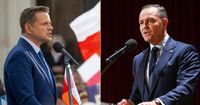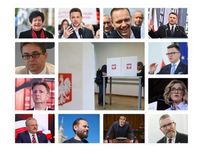In a series of recent polls, Rafał Trzaskowski of Koalicja Obywatelska has emerged as a strong contender for the Polish presidency, showcasing a significant lead over his main rival, Karol Nawrocki of PiS. According to the latest survey conducted by United Surveys for Wirtualna Polska, Trzaskowski is projected to secure 31.6 percent of the votes in the first round of the upcoming presidential elections, while Nawrocki trails with 24.7 percent, marking a decrease of 2.9 percentage points since the last poll.
The polling data reveals a notable trend in voter preferences, with Trzaskowski maintaining a solid lead despite a slight dip in support, down 0.1 percentage points from previous surveys. This stability halts a concerning decline that had been observed in earlier polls. Meanwhile, Nawrocki's drop in support signals potential challenges for his campaign.
Sławomir Mentzen from Konfederacja has also gained traction, securing 12.8 percent of the votes, a rise of 1.5 percentage points. This positions him as a notable third contender in the race, while other candidates, including Szymon Hołownia (8 percent), Magdalena Biejat (5.6 percent), and Adrian Zandberg (4.3 percent), continue to struggle to gain significant ground.
The United Surveys poll, conducted between April 28 and April 29, 2025, utilized CATI (telephone interviews) and CAWI (online interviews) methods on a representative sample of 1,000 individuals. This survey indicates that 6 percent of respondents remain undecided about their preferred candidate.
In a hypothetical second-round matchup, Trzaskowski is projected to win decisively, garnering 53.3 percent of the votes compared to Nawrocki's 39.5 percent. This scenario reflects a growing confidence in Trzaskowski's campaign, as he has gained 2.8 percentage points since the previous survey, while Nawrocki has seen a decrease of 0.7 percentage points.
Polling results from the Instytut Badań Pollster, conducted after a recent presidential debate organized by "Super Express," further underscore Trzaskowski's dominance. This poll indicates that he leads with 33 percent support, although this is a decrease of 1 percentage point from earlier polling. Nawrocki has gained 1 percentage point, reaching 25 percent, while Mentzen remains in third with 15 percent support.
The Pollster survey, conducted on April 28-29, 2025, also highlights the marginal support for other candidates, with Szymon Hołownia at 7 percent, Adrian Zandberg at 6 percent, and both Grzegorz Braun and Magdalena Biejat at 4 percent. This suggests that the race for the presidency is increasingly consolidating around three main candidates.
As the election date approaches, with the first round set for May 18, 2025, and a potential second round on June 1, 2025, the dynamics of the race will continue to evolve. The presence of 13 candidates, including notable figures like Artur Bartoszewicz, Joanna Senyszyn, and Krzysztof Stanowski, adds complexity to the electoral landscape.
The polling data has sparked discussions among political analysts regarding the effectiveness of each candidate's campaign strategies, particularly in light of the recent debates and public engagements. Trzaskowski's performance in the debate has been well-received, with 31 percent of respondents indicating that he was the standout candidate, while Nawrocki and Mentzen followed with 27 percent and 12 percent, respectively.
Voter engagement appears to be a critical factor in this election cycle, as evidenced by the high percentage of undecided voters. With 7.2 percent indicating uncertainty in their choices, both Trzaskowski and Nawrocki will need to intensify their outreach efforts to sway these voters in their favor.
The upcoming weeks will be crucial for all candidates as they ramp up their campaigns, seeking to solidify their support bases and attract undecided voters. The contrasting trajectories of Trzaskowski and Nawrocki could define the outcome of the elections, making the stakes particularly high for both campaigns.
As the political landscape shifts, observers will be closely monitoring how the candidates adapt their strategies and messaging in response to the polling data. The interplay between public perception and campaign tactics will likely influence voter turnout and the overall success of each candidate on election day.
In conclusion, the latest polling results paint a picture of a competitive presidential race in Poland, with Rafał Trzaskowski currently leading but facing challenges from Karol Nawrocki and Sławomir Mentzen. With the elections just around the corner, the candidates must leverage every opportunity to connect with voters and convey their visions for the future of the country.

![Wybory prezydenckie 2025. Kto ma największe szanse w II turze? [SONDAŻ]](https://thumbor.evrimagaci.org/M9G9Inx56VT2Ql1nQVh6KHNJwL8=/200x0/tpg%2Fsources%2F18dc4cfd-2a92-4697-9298-094f47d680cc.jpeg)




